A New Riesling Generation
Part
2
Rheinhessen, the Pfalz and Nahe
Posted July 31 2008
By Daenna Van
Mulligen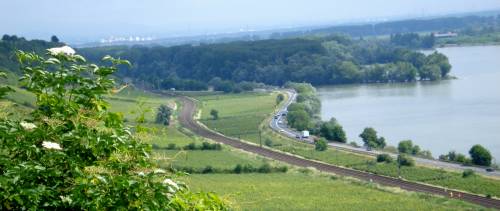
Rheinhessen - hilltop overlooking the Rhein River
For most
Riesling lovers Germany is unarguably the king. Germans will tell you that not
only do they have the best mineral soil for growing Riesling but that the best
latitude for cultivating Riesling is 48-51˚ latitude. My traveling companion was
reminded, on several occasions, that this was the same latitude as his home town
– Winnipeg. The Northern Hemisphere countries of Alsace, Austria nor Canada
would disagree with that statement – both have primary growing regions within
the same latitudes.
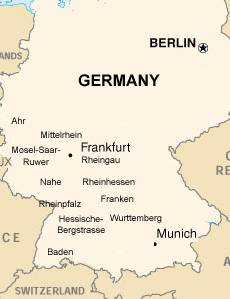
In part 2 I'll introduce you to the three regions of Rheinhessen, the Pfalz and
Nahe.
And, if you just happen to be looking at a map of German wine regions you’ll
notice that together the three form the shape of a comma. Nahe sits at the head
of the comma, Rheinhessen is the hook and Pfalz is the tail. You can traverse
these regions however you chose but during a recent trip, my group left the
Rheingau (read part 1) and drove south to the Rheinhessen, down to Pfalz and then
traveled back upward to Nahe before finishing in the Mosel (coming in part 3).
Rheinhessen
Germans describe the Rheinhessen region as the “land of a thousand hills”, which
lies within a large elbow of the Rhein River. And, after leaving the much
flatter Rheingau region, the slopes that swing up and away from the Rhein River
are obvious.
Rheinhessen is the largest of the 13 German wine regions with about 27,000
hectares of vineyards. But, perhaps its former reputation as a producer of
cheap, sweet wines - especially the unending reputation of Liebfraumlich and its
most infamous Blue Nun – left a unpleasant taste in the mouths of those wine
drinkers who had moved on to drier trends.
Gunderloch
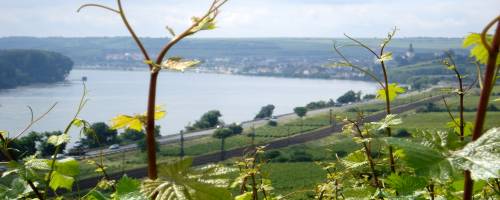
View of the Rhine from
the Gunderloch vineyards
In the village of Nackenheim we visited the well-known winery and tasting room
of the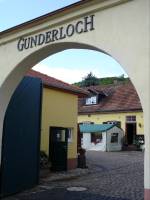 family owned estate of Gunderloch. In 1890 Carl Gunderloch purchased hillside
vineyards along this portion of the Rhein River - the most significant being in
the Rothenberg, just outside of Nackenheim. The Rothenberg Nackenheim is 50
hectares in total and is a site revered for its mineral-rich red soil and
premium, steep slopes. Five generations later, the family still lives in
Nackenheim and farm Rothenberg vineyards along with others in the Rheinhessen
region. The name Gunderloch remains yet the winery has passed into the female
hands of the family – the family name now being Hasselbach.
family owned estate of Gunderloch. In 1890 Carl Gunderloch purchased hillside
vineyards along this portion of the Rhein River - the most significant being in
the Rothenberg, just outside of Nackenheim. The Rothenberg Nackenheim is 50
hectares in total and is a site revered for its mineral-rich red soil and
premium, steep slopes. Five generations later, the family still lives in
Nackenheim and farm Rothenberg vineyards along with others in the Rheinhessen
region. The name Gunderloch remains yet the winery has passed into the female
hands of the family – the family name now being Hasselbach.
The wines here are highly aromatic with an amazingly lush texture. They lean
toward honeyed and off-dry but have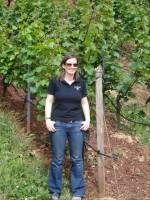 lovely acid balance. Gunderloch strives to retain the natural fruit sweetness in
their wines and to ensure roundness and softness on the palate they mature the
wines, on their lees, in large neutral oak casks.
lovely acid balance. Gunderloch strives to retain the natural fruit sweetness in
their wines and to ensure roundness and softness on the palate they mature the
wines, on their lees, in large neutral oak casks.
Kathrin Hasselbach-Bordiehn in the Nackenheim Rothenberg
The Gunderloch Estate Riesling Dry, 2007 is an everyday fresh Riesling
with bright citrus and white fruit aromas. Its off-dry yet balanced with
appealing white peach flavours on the palate.
The *Gunderloch Jean-Baptiste Riesling Kabinett Feinherb, 2007
reveals quite abundant aromas of melon and peach and citrus and has a clean,
off-dry palate with that is well balanced with zippy, mouth-watering finish.
(the 2006 $16.95 in LCBO stores the 2005 is $19.95 SAQ)
*Gunderloch Nackenheim Rothenberg Riesling Spätlese, 2006 is delectable. It
shows vibrant green apple, white floral, clean mineral and fresh stone fruit and
citrus aromas. It’s silky and rounded with loads of apple/stone fruit and slate
minerality flavours. (the 2003 is $33 SAQ)
aromas. It’s silky and rounded with loads of apple/stone fruit and slate
minerality flavours. (the 2003 is $33 SAQ)
And the *Gunderloch Nackenheim Rothenberg Riesling
Auslese, 2006 stands apart from the others with its earthy, mushroomy
aromas and intense minerality on the nose. The lush texture strokes your palate
with ripe peach, mango, chamomile and honey flavours. It has a long, powerful
finish and maintains its bright acidity throughout.
Right - look for a new everyday drinking wine from Gunderloch
called Fritz's Riesling
The wines with the asterisk(*) are wines that may be arriving in BC and look for
them in the Western Provinces and Ontario as well.
For more information on Gunderloch
click here
Heyl Zu Herrnsheim/St.
Antony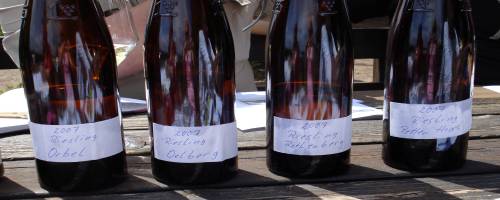
Four Erste Lage
(First Site) barrel samples from Heul Zu Herrnsheim and St. Antony
Heyl Zu
Herrnsheim is a good example of tradition saved by modern methods. The estate
dates back to 1561 but has changed hands several times since. In the 1700s it
was taken over by the Lauteren family who claimed bragging rights to producing
the first sparkling wine “Sekt” in Germany. Then, after three generations in the
possession of the Lauteren family it was purchased in 1909 by the Heyl family
who then sold in it to the Ahr family in 1994 who in turn sold it to Detlev
Meyer in 2006. As we know, running a winery takes a huge financial toll, and
Meyer has been able to invest in the future of the estate through updates and
modernization in all aspects; marketing, the vineyards and the winery. Heyl Zu
Herrnsheim and its sister winery St.Antony are both located in Nierstein (in the
former winery of Gustav Adolf Schmitt) and although we did pass through
Nierstein we tasted several wines from both wineries on a hilltop overlooking
the nearby estate vineyards and Rhine River.
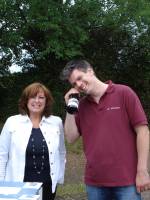
The finest of their vineyards are located between Nackenheim and Nierstein on
the five kilometer stretch of the Roter Hang - a mineral-rich red slope which
imparts herbal aromas and flavours to wine. These steeply sloped, premium
vineyards include the famed Brudersberg, a 1.3 hectare Riesling vineyard which
is considered one of the
Grosses Gewächs or “great
growth” sites in Germany (read about the classification
or GG
here). As well, Heyl Zu
Herrnsheim owns parcels in two other GG sites; the Pettenthal (also 100%
Reisling and 3.5 hectares)
and, like Gunderloch, in the Nackenheimer Rothenberg
(2.7 hectares containing
Riesling and Sylvaner). The tasting was lead by winemaker Felix Peters and
Andrea Gauer (photo at right) who brought barrel samples of the 2007
vintage for us to sample.
Heyl Zu Herrnsheim Riesling Kabinett, 2007 – This was the only
already-in-bottle we tasted, a fresh, crisp wine with citrus, steely minerality and peaches. The
great 2007 vintage shows through, the; acid, fruit, sweet and alcohol, very
well-balanced.
we tasted, a fresh, crisp wine with citrus, steely minerality and peaches. The
great 2007 vintage shows through, the; acid, fruit, sweet and alcohol, very
well-balanced.
Heyl Zu Herrnsheim Nierstein Pettenthal Riesling
Grosses Gewächs,
2007 –
Made from 30 +
year old vines from an organic vineyard this wine has some fat aromas – elegant
minerality and juicy citrus, a hint of herbs – powerful.
Heyl Zu Herrnsheim
Nackenheim Rothenberg Riesling
Grosses Gewächs, 2007 –
Unique
concentrated aromas – quite fat with an earthy, smoky almost meatiness to it
alongside bright citrus and obvious herbal notes. The palate is complete,
balanced, potent and ripe and dry - elegant.
St. Antony Nierstein Orbel Riesling Grosses Gewächs, 2007
is a fresh dry
Riesling showing consistent power and bold minerality that all the St.Antony and
Heyl Zu Herrnsheim showed.
St. Antony Nierstein Ölberg Riesling Grosses Gewächs,
2007
shows lovely
white grapefruit, floral and zest aromas – this wine comes from a very small
vineyard with very low yields and picks up a rounded, earthy palate from its
time in neutral old barriques.
Unfortunately none of these wines are currently available in Canada that I am
aware of.
Pfalz
Known as the Palatinate
winegrowing region, the Pfalz is Germany’s “sunshine state”. It has a
virtual Mediterranean clime which allows for the growth of almonds, figs and
citrus. Protected on the west by the Palatine forest and by the Haardt Mountains
(a continuation of the Vosges mountain range from Alsace) the Pfalz is only
slightly smaller than Rheinhessen with just over 23,000 hectares of vineyards.
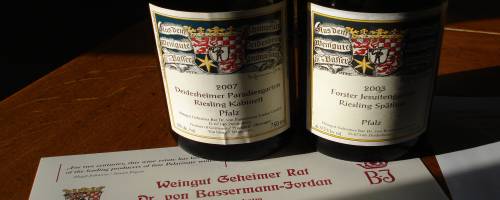
wine
tasting at Weingut Geheimer Rat Dr.v.Bassermann~Jordan
Bassermann-Jordan
For its sheer historical and
political connections the Bassermann-Jordan winery wins the Pfalz intrigue tour.
Founded in 1718 you can read the history of the family tree on the
website starting back in 1775
with Andreas Jordan then continue through the addition of the Bassermann name to
the family estate in 1883 and onto Friedrich von Bassermann~Jordan the wine book
author.
The last of the von Bassermann~Jordan family owners Margarit von
Bassermann~Jordan and her daughter Dr. Gabriele von Bassermann~Jordan took over
in 1995 when Margarit’s husband and Gabriele’s father Ludwig passed away. In
2002 the winery was taken over by entrepreneur businessman Achim Niederberger.
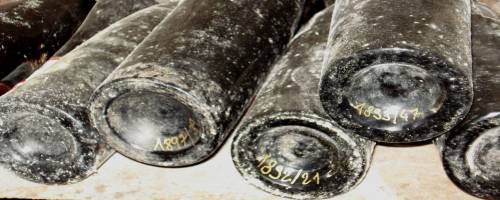
the cave treasury
at Bassermann~Jordan - Rieslings from the late 1800s
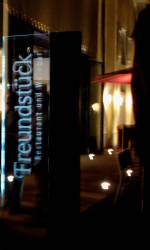
The winery sits in the
lovely town of Deidesheim.
The cellar caves curve under the winery studded with artifacts and a private
treasury (what we call a library) of back vintages. Manager Gunther Hauck led us
through the cellars, where we chose a 1945 Riesling to open.
After a tasting a selection of stunning wines we walked down the street to the
Ketschauer~Hof Hotel Bar & Restaurant
– Freunstück – a stunning, old-meets-ultra-modern venue. Seriously not to be
missed if you are in the area.
Tasted at Weingut Geheimer Rat Dr.v.Bassermann~Jordan
Bassermann~Jordan Riesling,
2007- this
‘trocken’ or dry Riesling is crisp, fresh and citrus-y with lots of white
fruit and minerality. (the 2006 is available in LCBO stores for $21.95)
Bassermann~Jordan HohenMorgen Deidesheim Riesling GG (Grosses
Gewächs),
2006 shows apple peel, white grapefruit and a hint of honey that lingers.
Mouth-filling and quite lush with fresh acidity that cleans up on the finish.
Bassermann~Jordan
Deidesheimer Paradiesgarten Riesling Kabinett, 2007
fresh tree fruits and grapefruit, it’s just off-dry with a rich texture, loads
of minerally flavours and a smooth, clean finish.
The
Bassermann~Jordan Deidesheimer Paradiesgarten Riesling Kabinett, 2004
(photo at
right)
Has the
benefit of some age and has a honey-hue with ripe apricot, lemon drops, slate,
petrol and honey blossoms. On the palate it shows an initial spritz of sweet
lemon followed by stone fruit, slate and candied citrus peel. It's off-dry but
has mouth-watering acidity - beautiful!
(The 2004 is still available in select private wine stores in BC for $30+.
This label may also be available in Quebec and Alberta)
Bassermann~Jordan Forster Jesuitengarten Riesling Spatlese , 2003- The 2003
vintage was hot and dry which elevated the alcohol levels. The aromas show
petrol, are rich and earthy with ripe apple, mango, apricot and exotic citrus
notes. Weighty and off-dry on the palate but balanced with fresh acidity. A
delicious wine!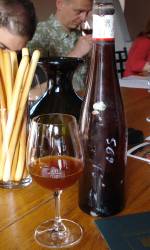
As I mentioned, we also
tasted a
Bassermann~Jordan Deidisheimer HohenMorgen Riesling, 1945 (see
right)
It was the colour of caramel with aromas of roasted apricots and stewed apples
and toffee. The palate still showed bright acidity and had flavours of mulled
apple cider with orange peel and cloves.
Click here for more info on
Bassermann~Jordan
Lingenfelder
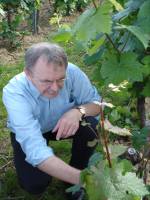
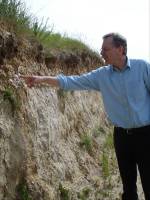
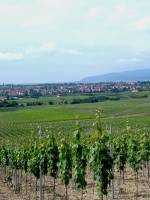
Rainer-Karl Lingenfelder: in the vines, showing the loess soils and new
plantings
Well, what can I say about Rainer Lingenfelder?
That he is undeniably, the biggest proponent of German wines I’ve met. I would
doubt anyone who has ever met Rainer-Karl Lingenfelder could forget him. His
sparkling eyes, barely restrained energy and enthusiasm and of course, his
moustache. I’d met Rainer, in Canada, three times from 2001 thru 2008 but
meeting him a fourth time - in his natural habitat – was a delight. He bounced
from one gently sloping vineyard to the next, showing us his early flowering
vines, critters in his newest vineyard, and the land laying fallow.
Rainer Lingenfelder promotes German wines as a whole, despite the fact that he’s
taken a very different approach to marketing his own. If you are a Riesling
lover you’ll recognize the “Bird Label” which provided consumers with a well
made Pfalz Riesling with a non-traditional and easy-to-read-label. Rainer
recognized that consumers outside of Germany were confused by traditional German
labels – no surprise there. He knew that if he wanted to sell wine outside of
Germany he had to create a label that would appeal to consumers and get them
drinking Riesling. It worked – what started out as the artist Chuck House’s
rendition of a bird on a label morphed into simply becoming the “Bird Label”
internationally. What followed was a series of labels called the “Vineyard
Creatures” simple and memorable, without the mystification of appellation or VDP
Prädikat status.
For more information German wine labels
click here
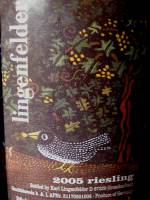
Lingenfelder “Hare Label” Gewurztraminer QbA, 2005 – Peachy aromas with
warm spice, orange blossoms and rose oil. Slightly creamy in texture with spiced
lychee flavours and bold minerality. Very enjoyable.
Lingenfelder “Bird Label” QbA, 2007 the most famous (and the first) of
the Vineyard Creatures series it shows bright, juicy white fruits and minerals.
It has a lovely, gently rounded texture with silky apple and citrus flavours and
a mouth-watering finish. (Will be arriving in BC and across Canada this fall
but the 2005 Bird Label is available in Ontario for $14.95)
Lingenfelder
“SATYR” Riesling Sekt Brut, NV
has long been a favorite sparkling wine of mine - when I can find it. After 10
years on the lees it has an intense honey-yellow hue and persistent bubbles.
Ripe aromas – honey, stone fruits and apple that return on the palate with
layers of chamomile, minerals, yeasty notes and sweet herbal hints. Crisp and
very complex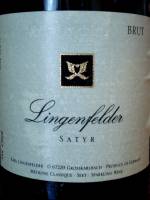
(Look for this in private stores and restaurants soon).
Lingenfelder Riesling Kabinett, 2007 is a gorgeous aromatic compilation
of citrus rind, white peach, apples, honey and lemon drops with a hint of herbs.
Off-dry and spritzy fresh on the palate with honey, stone fruit and apple
flavours. I’m putting in my order and hope this wine arrives in BC. From the
Freinsheimer Musik’ buckle vineyard.
And the Lingenfelder Scheurebe TBA, 2005 is made from 45 year old vines and
has stunning, earthy aromas – caramel, sweet spice, raisin and mushroom-y notes
with a thick, unctuous body and flavours of saltwater taffy and dried fruits
linger. Made every 10 years - Freinsheimer Goldberg vineyard.
For more on Lingenfelder and the wines of the age of PostChardonnism -
click here
The Lingenfelder wines
have agency representation across Canada so be sure to go into your local wine
store of government liquor store and ask for them.
Lucashof
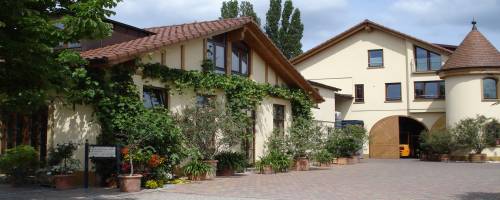
Lucashof winery and hotel in Forst
Lucashof a smaller family
owned winery located in Forst, not far from Deidesheim in the Pfalz region. The
Lucas family estate is now around 25 hectares with vineyards in some of the
regions best sites; Forster Ungeheuer, Forster Pechstein, Forster Elster and
Forster Musenhang. They produce sparkling and still wines made from Riesling,
Pinot Blanc, Dornfelder and Spatburgunder (Pinot Noir) but one of the most
interesting things about Lucashof is their family connection to the Cave Spring
Winery in Ontario.
The week before my visit Germany was hit by hailstorms (especially the Pfalz)
which Christine Lucas estimated destroyed at least 20% of their 2008 crop.
The winery also (see the photograph) has a very nice little hotel with seven
rooms which you can read more on by
clicking here .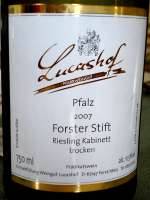
Lucashof Forster Stift
Riesling Kabinett Trocken, 2007
shows fruit forward aromatics, peaches, apricots and honey with a juicy, off-dry
palate and zesty citrus flavours. Easy drinking – every day patio sipper.
Lucashof Forster Elster Riesling Kabinett Trocken, 2007 like the Forster
Stift, this vineyard is 20 years old ad is similarily fruity on the nose with
bright orchard fruit and citrus aromas. It’s bigger on the palate with more
depth than the Forster Stift though – zippy and zesty with obvious minerality,
citrus and white fruits. (* I was told this wine is available in Ontario for
about $16)
Lucashof Forster Elster Riesling Kabinett, 2007 has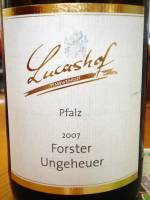 power and intensity. Its rounder, fuller-bodied, dry and super crisp – almost
angular - with lingering acidity.
power and intensity. Its rounder, fuller-bodied, dry and super crisp – almost
angular - with lingering acidity.
Lucashof Forster Musenhang Riesling Feinherb, 2007 (for a description
of Feinherb and other German labeling terms
click here) Ripe tree fruits a hint of spice, powerful with a slightly
creamy texture yet crisp and lingering.
Lucashof Forster Ungeheuer Riesling Spätlese Trocken, 2007 an almost oily
texture with rich fruit, tart citrus peel, licorice/fennel, sweet herbal hints
and a warm finish. Interesting wine – dry yet ripe and fresh.
Finally, the Lucashof Forster Ungeheuer Riesling Auslese, 2007 is a very
nice sweet wine with crisp apricot,honey and chamomile aromas. On the palate
it’s sweet and rich but has bright acidity to back it up with flavours of honey,
apples, and apricots. The finish is commanding and clean.
Nahe
Perhaps lesser known than
the Pfalz, Rheinhessen and Rheingau, Nahe nonetheless is home to some of the
most famous and quality producers in Germany – Schlossgut Diel, Kruger~Rumpf and
Dönnhoff. The region itself is just over 4000 hectares with various soil types
which produce Rieslings that are quite delicate to elegant as well as powerful
and minerally.
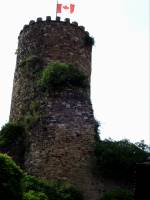
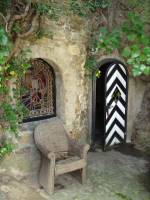
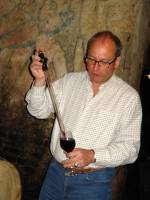
Tower of Burg Layen flying the Canadian Flag, a door into tower, Armin Diel & a
wine thief
Schlossgut Diel
Polished and contemporary.
Although, Schlossgut Diel itself is not modern - rather a tower and the walled
remnants of castle Burg Layen in the village of Rümmelsheim. It was built prior
to 1200, changed hands numerous times over the centuries but was finally
purchased by Johann Peter Diel in 1802.
Current resident and Renaissance man Armin Diel is as polished and contemporary
as his wines - wine and food journalist, author as well as traveling winemaker.
The internationally recognized Ernst Loosen (who, in partnership with Chateau
Ste.Michelle in Washington State produces the Eroica Riesling) introduced Alan
Shoup to Armin Diel to partner in making his
Long Shadows Poet’s
Leap Riesling which he has been a part of since the initial 2003 crush in
Washington.
Diel took over the estate from his father in 1987, and now, his daughter
Caroline has taken over as winemaker.
If you can find these amazing wines - and I highly recommend trying - you will
be rewarded, as they are elegant and will introduce you to a style of wine you
have never experienced.
The Diel Riesling Sekt, 2004 a wonderful, fresh bubbly that is both
creamy and crisp with hints of toast.
Rose de Diel, 2007
is made from 100% Pinot Noir and was a refreshing change from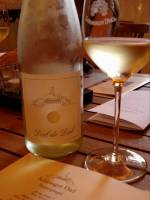 a week of Riesling. The colour is pale salmon/blush in colour with clean citrus
and sweet berry aromas. Its silky and fresh a perfect crisp summer sipper. When
I called it delicious, Armin correct me with Diel-icious.
a week of Riesling. The colour is pale salmon/blush in colour with clean citrus
and sweet berry aromas. Its silky and fresh a perfect crisp summer sipper. When
I called it delicious, Armin correct me with Diel-icious.
Diel de Diel,
2007 is a
combination of two-thirds Pinot Gris (Grauburgunder) with Riesling and
Pinot Blanc (Weissburgunder) showing aromas of white fruits and citrus
with mineral tones. It’s clean on the palate with a rounded texture and flavours
of peaches, orange rind and a suggestion of spice.
Diel Burg Layen Schlossberg Riesling,
Grosses Gewächs,
2007 an elegant,
dry Riesling with rich peach/apricot, honey, petrol and chamomile aromas that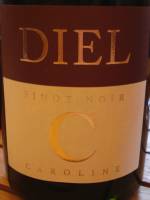 reappear on the palate alongside lively citrus and potent minerality.
reappear on the palate alongside lively citrus and potent minerality.
Diel Pittermännchen Riesling Kabinett, 2007 a single vineyard off-dry
Riesling with honey, crisp green apple and bright citrus, mineral and sweet
zesty flavours. Elegant, with an age-ability of a decade or more.
Diel ‘Cuvee
Caroline’ Pinot Noir, 2006
is named after Armin’s daughter and the vineyards are 20-30 years old. This was
the best Pinot Noir I tasted on my German wine tour – it shows beautiful layered
aromatics of bright red berries and cherries, sweet tobacco and fragrant purple
flowers. Elegant and Burgundian-like with a silky texture, spiced fruit, cedar
box and peppery flavours and fine youthful tannins.
For more information on Schlossgut Diel
click here
Kruger~Rumpf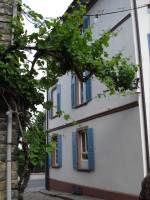
After a trip down the Rhine in a paddlewheel
to Bingen we traveled to
Münsterer-Sarmsheim where we visited Stephen Rumpf at Kruger~Rumpf. Weingut
Kruger~Rumpf is located in a family manor house and farmhouse built in 1830.
We dined and tasted his wines in his quaint setting of his family run
restaurant/tavern that specializes in serving traditional cuisine. Kruger~Rumpf
grows a selection of Riesling, Spätburgunder (Pinot Noir), Silvaner, Scheurebe,
Grauburgunder (Pinot Gris). Weissburgunder (Pinot Blanc) and Gewurztraminer. A
total of 55 hectares are spread throughout the various vineyards of; Münsterer
Pittersberg,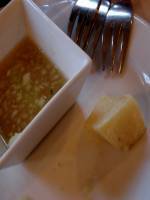 Münsterer Dautenpflänzer, Münsterer Rheinberg, Münsterer Kappellenberg,
Dorsheimer Castle Hill and one hectare in Binger Scharlachberg in the
Rheinhessen. The family were wonderful hosts, we spent the evening tasting wines
with Stephen paired with delicious, fresh dishes made by his wife (and a fresh
local cheese called hand kase at right) while we replayed our previous six days
of travel.
Münsterer Dautenpflänzer, Münsterer Rheinberg, Münsterer Kappellenberg,
Dorsheimer Castle Hill and one hectare in Binger Scharlachberg in the
Rheinhessen. The family were wonderful hosts, we spent the evening tasting wines
with Stephen paired with delicious, fresh dishes made by his wife (and a fresh
local cheese called hand kase at right) while we replayed our previous six days
of travel.
Kruger~Rumpf “S” Weisser Burgunder (Pinot Blanc) trocken, 2007 –
“S” means selection and this lovely Pinot Blanc is capped in silver for simple
identification. It shows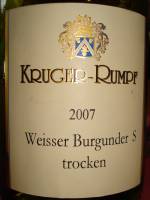 creamy white fruit on the nose with floral, peachy and pear notes vanilla and a
hint of vanilla. Rich on the palate, off-dry and fresh with a bright finish and
more spice. Very nice!
creamy white fruit on the nose with floral, peachy and pear notes vanilla and a
hint of vanilla. Rich on the palate, off-dry and fresh with a bright finish and
more spice. Very nice!
The Kruger~Rumpf Münsterer Riesling, 2007 is a trocken riesling with
bright aromas of peach, pear, chalk and slate minerality with fragrant floral
notes. Quite lush on the palate, fruity, minerally and clean, a hint of natural
spice with lovely acidity and lingering flavours.
Kruger~Rumpf Münsterer Pittersberg ‘S’ Riesling Kabinett, 2007 is also a
silvercap selection showing ripe orchard fruit on the nose with honey, lemon,
slate and grapefruit-y notes. Creamy on the palate with lively acidity and fresh
lemon flavours.
Kruger~Rumpf Münsterer Dautenpflänzer
‘GG’
(Grosses Gewächs),
2007 upfront, ripe stonefruit and pear aromas. Smooth and rounded on the palate
with layered fruit and minerality and bright acidity.
Kruger~Rumpf Münsterer Kappellenberg Riesling Kabinett, 2007 off-dry with
sweet peach/apricot and crisp green apple aromas with undertones of lemon-balm
and herbs. Its bright and refreshing on the palate with hints of candied zest
but finishes mouth-watering.
The 2006 Kruger~Rumpf Münsterer Kappellenberg Riesling Kabinett has tart
aromas of crab apple and grapefruit with lemon zest. On the palate it’s off-dry
with a slick, weighty texture and pops with flavours of iced tea, gala apples
and honey with gorgeous minerality. The finish is zesty with mouth-watering
acidity. And with a mere 10% alcohol, why wouldn’t you want to drink this
everyday? (see photo
right)
*the 2006 is available in Specialty BC Liquor Stores for $24.99
Kruger~Rumpf Münsterer Rheinberg Riesling Kabinett, 2007 is a bright and
fruity with peaches, honey, apricots and gorgeous acidity. The 2006 can be found
in LCBO Vintages for $19.95.
We were also fortunate enough to convince Stephen to pull a Kruger~Rumpf
Pinot Noir ‘R’, 2005 from his cellar (the ‘R’ stands for reserve ion this
case) and second only to the Diel it was the best of the Pinot Noirs I tasted in
Germany. Fresh - with cherries, leather and barnyard aromas and undertones of
sweet violets. Velvety on the palate, sweet red fruit prevailed with vanilla,
cherry, minerals and a bright finish with peppery spice.
For more information on Weingut Kruger~Rumpf
click here
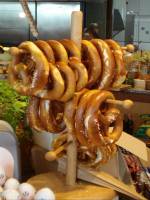
*Also coming into BC and
Alberta from Nahe, (although I have yet to taste them) the famous wines of
Dönnhoff should be arriving this summer 2008.
Coming
next Germany part 3 - The Mosel
To read Germany part 1 - the Rheingau
click
here
To read "Understanding" German wine labels
click here
-end-




 family owned estate of Gunderloch. In 1890 Carl Gunderloch purchased hillside
vineyards along this portion of the Rhein River - the most significant being in
the Rothenberg, just outside of Nackenheim. The Rothenberg Nackenheim is 50
hectares in total and is a site revered for its mineral-rich red soil and
premium, steep slopes. Five generations later, the family still lives in
Nackenheim and farm Rothenberg vineyards along with others in the Rheinhessen
region. The name Gunderloch remains yet the winery has passed into the female
hands of the family – the family name now being Hasselbach.
family owned estate of Gunderloch. In 1890 Carl Gunderloch purchased hillside
vineyards along this portion of the Rhein River - the most significant being in
the Rothenberg, just outside of Nackenheim. The Rothenberg Nackenheim is 50
hectares in total and is a site revered for its mineral-rich red soil and
premium, steep slopes. Five generations later, the family still lives in
Nackenheim and farm Rothenberg vineyards along with others in the Rheinhessen
region. The name Gunderloch remains yet the winery has passed into the female
hands of the family – the family name now being Hasselbach.  lovely acid balance. Gunderloch strives to retain the natural fruit sweetness in
their wines and to ensure roundness and softness on the palate they mature the
wines, on their lees, in large neutral oak casks.
lovely acid balance. Gunderloch strives to retain the natural fruit sweetness in
their wines and to ensure roundness and softness on the palate they mature the
wines, on their lees, in large neutral oak casks. aromas. It’s silky and rounded with loads of apple/stone fruit and slate
minerality flavours. (the 2003 is $33 SAQ)
aromas. It’s silky and rounded with loads of apple/stone fruit and slate
minerality flavours. (the 2003 is $33 SAQ) 

 we tasted, a fresh, crisp wine with citrus, steely minerality and peaches. The
great 2007 vintage shows through, the; acid, fruit, sweet and alcohol, very
well-balanced.
we tasted, a fresh, crisp wine with citrus, steely minerality and peaches. The
great 2007 vintage shows through, the; acid, fruit, sweet and alcohol, very
well-balanced.











 power and intensity. Its rounder, fuller-bodied, dry and super crisp – almost
angular - with lingering acidity.
power and intensity. Its rounder, fuller-bodied, dry and super crisp – almost
angular - with lingering acidity.


 a week of Riesling. The colour is pale salmon/blush in colour with clean citrus
and sweet berry aromas. Its silky and fresh a perfect crisp summer sipper. When
I called it delicious, Armin correct me with Diel-icious.
a week of Riesling. The colour is pale salmon/blush in colour with clean citrus
and sweet berry aromas. Its silky and fresh a perfect crisp summer sipper. When
I called it delicious, Armin correct me with Diel-icious. reappear on the palate alongside lively citrus and potent minerality.
reappear on the palate alongside lively citrus and potent minerality. 
 Münsterer Dautenpflänzer, Münsterer Rheinberg, Münsterer Kappellenberg,
Dorsheimer Castle Hill and one hectare in Binger Scharlachberg in the
Rheinhessen. The family were wonderful hosts, we spent the evening tasting wines
with Stephen paired with delicious, fresh dishes made by his wife (and a fresh
local cheese called hand kase at right) while we replayed our previous six days
of travel.
Münsterer Dautenpflänzer, Münsterer Rheinberg, Münsterer Kappellenberg,
Dorsheimer Castle Hill and one hectare in Binger Scharlachberg in the
Rheinhessen. The family were wonderful hosts, we spent the evening tasting wines
with Stephen paired with delicious, fresh dishes made by his wife (and a fresh
local cheese called hand kase at right) while we replayed our previous six days
of travel. creamy white fruit on the nose with floral, peachy and pear notes vanilla and a
hint of vanilla. Rich on the palate, off-dry and fresh with a bright finish and
more spice. Very nice!
creamy white fruit on the nose with floral, peachy and pear notes vanilla and a
hint of vanilla. Rich on the palate, off-dry and fresh with a bright finish and
more spice. Very nice!
